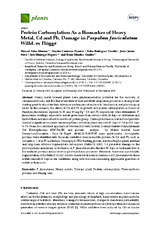Mostrar el registro sencillo del ítem
Protein Carbonylation As a Biomarker of Heavy Metal, Cd and Pb, Damage in Paspalum fasciculatum Willd. ex Flüggé
| dc.contributor.author | Salas Moreno, Manuel | |
| dc.contributor.author | Contreras Puentes, Neyder | |
| dc.contributor.author | Rodríguez-Cavallo, Erika | |
| dc.contributor.author | Jorrín-Novo, Jesús V. | |
| dc.contributor.author | Marrugo-Negrete, José | |
| dc.contributor.author | Méndez-Cuadro, Darío | |
| dc.date.accessioned | 2019-11-18T10:59:57Z | |
| dc.date.available | 2019-11-18T10:59:57Z | |
| dc.date.issued | 2019 | |
| dc.identifier.uri | http://hdl.handle.net/10396/19129 | |
| dc.description.abstract | Heavy metal tolerant plants have phytoremediation potential for the recovery of contaminated soils, and the characterization of their metabolic adaptation processes is an important starting point to elucidate their tolerance mechanisms at molecular, biochemical and physiological levels. In this research, the effects of Cd and Pb on growth and protein carbonylation in tissues of Paspalum fasciculatum exposed to 30 and 50 mg·Kg-1 Cd and Pb respectively were determined. P. fasciculatum seedlings exposed to metals grew more than controls until 60 days of cultivation and limited their oxidative effects to a reduced protein group. Carbonyl indexes in leaf and root proteins reached a significant increase concerning their controls in plants exposed 30 days to Cd and 60 days to Pb. From the combined approach of Western Blot with Sodium Dodecyl Sulfate-Polyacrylamide Gel Electrophoresis (SDS-PAGE) and protein analysis by Matrix Asisted Laser Desorption/Ionisation - Time Of Flight (MALDI-TOF/TOF) mass spectrometry, chloroplastic proteins were identified into the main oxidative stress-inducible proteins to Cd and Pb, such as subunits α, γ of ATP synthetase, Chlorophyll CP26 binding protein, fructose-bisphosphate aldolase and long-chain ribulose bisphosphate carboxylase (RuBisCO LSU). Cd generated damage in the photosynthetic machinery of the leaves of P. fasciculatum into the first 30 days of treatment; five of the oxidized proteins are involved in photosynthesis processes. Moreover, there was a proteolytic fragmentation of the RuBisCO LSU. Results showed that intrinsic tolerance of P. fasciculatum to these metals reached 60 days in our conditions, along with the bioaccumulating appreciable quantities of metals in their roots. | es_ES |
| dc.format.mimetype | application/pdf | es_ES |
| dc.language.iso | eng | es_ES |
| dc.publisher | MDPI | es_ES |
| dc.rights | https://creativecommons.org/licenses/by/4.0/ | es_ES |
| dc.source | Plants 8(11), 513 (2019) | es_ES |
| dc.subject | P. fasciculatum | es_ES |
| dc.subject | Heavy metals | es_ES |
| dc.subject | Tolerant plant | es_ES |
| dc.subject | Protein carbonylation | es_ES |
| dc.subject | Photosynthesis proteins | es_ES |
| dc.subject | Mining soils | es_ES |
| dc.title | Protein Carbonylation As a Biomarker of Heavy Metal, Cd and Pb, Damage in Paspalum fasciculatum Willd. ex Flüggé | es_ES |
| dc.type | info:eu-repo/semantics/article | es_ES |
| dc.relation.publisherversion | http://dx.doi.org/10.3390/plants8110513 | es_ES |
| dc.rights.accessRights | info:eu-repo/semantics/openAccess | es_ES |

